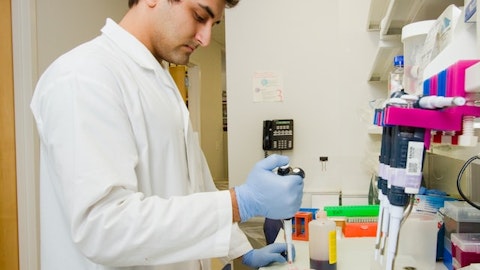Then certainly as we look at the opportunity for a product like Camzyos and a product like Sotyktu, we think the long-term potential still remains on track, and possibly for a product like Camzyos, in excess of what we had anticipated. Then as you would expect in any portfolio product, there are a couple of products where performance is lagging – we’ve highlighted what those are, but maybe I’ll ask Adam to comment on any additional underlying dynamics he wants to speak to.
Adam Lenkowsky: Yes, thanks for the question. I think when we look at the totality of the portfolio, we obviously see some products that are ahead where we projected them to be at peak, and some are tracking behind, but taken together, we don’t see any changes in what we had discussed, which was on a non-risk adjusted basis that the new product portfolio could exceed that objective by 2030. Chris talked about some of the pushes and pulls. I would just add Reblozyl is certainly a product that we’re seeing that is tracking at or even ahead of expectations with the Commands label. Camzyos, we also see that tracking ahead in the longer term. Yes, it’s taking slower than we initially guided to, but it’s tracking very similar to a very, very strong cardiovascular launch, and so we expect that adoption to continue with sustained growth into the near term.
Chris mentioned Breyanzi – you know, Breyanzi has been seeing–has the best-in-class self-therapy agent, and coming into next year, we’re going to be in a much better supply position and that is going to help accelerate and catalyze that product, and also Sotyktu as well, because if you think about Sotyktu, once we are able to secure access early next year, we’ll see accelerations in PSO but we also have important data read-outs, as you know, coming in PSA and in SLE, or lupus, which will contribute to having Sotyktu exceed potentially our expectations in the back end of the decade.
Chris Boerner: Tim, just to close it out, we have said that that product portfolio had $25 billion-plus potential. Where we sit today, we still see that potential – at least $25 billion as we get to the end of this decade.
Tim Power: Thanks Chris. Can we go to the next question please, Keith?
Operator: Yes, and it comes from David Risinger with Leerink Partners.
David Risinger: Yes, thanks very much. I just wanted to pivot to 2026. Considering that you extended the new product portfolio revenue guidance to ’26, could you please comment on both the in-line product segment and the recent LOE segments for ’26, specifically how you’d frame the magnitude of potential declines for Eliquis and Revlimid, given the pressures that they are set to face? Thank you very much.
David Elkins: Thanks David. Just as a reminder, as far as–the only change that we made was from the new product portfolio going to ’26. We’re not providing line item guidance for the other line items, but what I would like to do is just remind you there’s really no change to that in-line portfolio going from 2010 to 2025 at $8 billion to $10 billion. We feel very confident in that, and I think the double-digit growth you saw in Opdivo year-to-date demonstrates our continued confidence there. The only change that we’ve made in relation to the guidance was in that new product portfolio out to ’26. As it relates to the LOE, again we increased the guidance this year for Revlimid from 5.5 to 6, and as we’ve said on the second quarter, there’s really no change to how we’re looking at it, which is pretty consistent with where consensus is for ’24 and ’25, dropping down to about $4 billion next year and $2 billion in ’25.
Remember – by the time we finish this year, Revlimid will be beyond 60% of the erosion of that product, and a significant portion of our growth going forward is going to be represented by that in-line and new product portfolio. LOEs in 2025 will be less than 10% of our total revenue, so we’ll have a much younger portfolio by the time we get to ’25 and that will set us up well for ’26. That’s where we stand today.
Tim Power: Thanks David. Let’s go to the next question, please, Keith.
Operator: Yes, the next one is coming from Robyn Karnauskas with Truist.
Robyn Karnauskas: Hi. I think all the questions are focused on near term, but I have gotten a lot of bullish indicators on your launches, thinking more longer term, like next year. We’ve heard from KOLs that LVEF drops in the real world for Camzyos seem to be better than what we’re seeing in the clinical trials. Maybe you can provide some color on what you’re seeing and how that’s impacted uptake, and I think big picture, do you see any potential for changes to REMS because of what you’re seeing? Thanks.
Sarnit Hirawat: Thank you Robyn. I think what we have heard and what Adam has talked about in the past as well, that overall profile for Camzyos as we think about patients and the prescribers remains very, very positive, and we remain very confident on that profile as well. As it relates to the REMS impact, look – these are data that we have to collect for a long time from the real world. There is no commitment in terms of really getting the REMS changed, but certainly we will continue to try as more and more data evolves and more and more patients are put on Camzyos. Overall, once the patient goes on Camzyos, we have not heard of any stories of patients trying to get off Camzyos; in fact, even if they have to interrupt for any other reasons, they want to go back on the drug because of the benefit that they see in their quality of life and how they perform on their overall daily living.
Tim Power: Thanks Sarnit. Can we go to the next question, please?
Operator: Yes, and that comes from Mohit Bansal with Wells Fargo.
Mohit Bansal: Great, thank you for taking my question. My question is regarding–my question is related to Sotyktu, because it seems like in the prepared remarks, you mentioned that Sotyktu contracting to zero step edits may run to 2025, and you mentioned because there are some changes in the immunologic contracting market. Can you please help us understand that a little bit better – what are these changes, and how should we think about the long-term net pricing for this category? Thank you.
Adam Lenkowsky: Yes Mohit, thanks for the question. I’ll take that one. As I said, we are working to improve significantly our formulary access in 2024, and as I said, we have approximately 80% of lives today that are not covered on Sotyktu. We expect that to change dramatically as we move into next year; however, when you look at where we will likely be in 2024, we will likely have the majority of our business in either zero or one step edit position. When we’re talking to PBMs, and the reason why we’re talking a little bit about 2025, PBMs are really thinking about different ways to manage the PSO class, as well as the broader immunology class, with now more and more bio-similiar Humira coming into the market, and so those decisions have not yet been finalized for 2025.
But as I stated, we’re very confident that we will see a significantly broader access position next year, so we’ll go from non-covered to being covered, which will be a really nice growth opportunity for Sotyktu as we move into early next year.
Tim Power: Thanks Adam. Let’s go to the next question, please.
Operator: Yes, and that comes from Olivia Brayer with Cantor Fitzgerald.
Olivia Brayer: Hey, good morning, and thank you for the question. M&A has obviously been something that you guys have leaned into, so does that strategy change at all after the Mirati deal, and if there is still an appetite for midsized deals, are there certain areas that maybe best fit your growth strategy going forward?
Chris Boerner: Sure, let me take that one. As we’ve said consistently, business development remains the top priority for capital allocation at the company. What I would say is at a macro level, the way we think about business development is somewhat consistent with the way we’ve always thought about, which is we are going to be looking for deals that are scientifically interesting and related to things that we know well, that are going to be strategically relevant for the company and, of course, they have to be financially sound. The one thing that I would add is that we are going to index more heavily on those deals that enhance the growth profile of the company – that’s an area that we remain fixated on as a management team, and so I think that’s going to factor into how we think about business development going forward.





